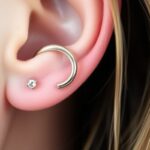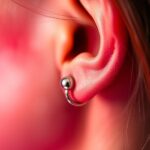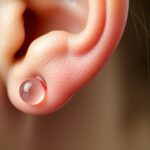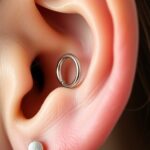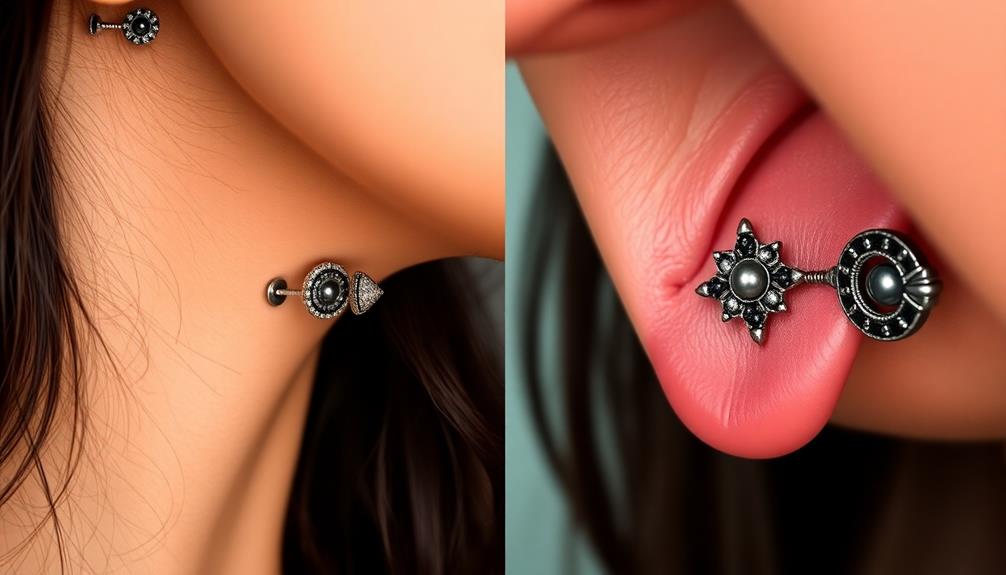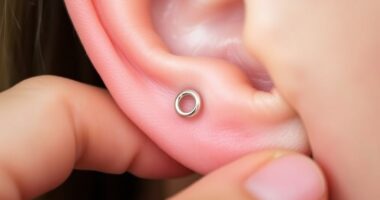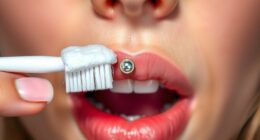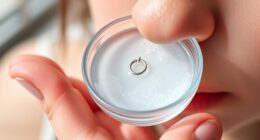Tragus piercings have a pain level of about 4 to 5 out of 10, often feeling like a sharp pinch. Healing time can take anywhere from 3 to 12 months, with the initial tenderness easing within 1 to 2 weeks. For jewelry, consider surgical stainless steel or titanium, which are safe options, and choose flat back studs or hoops with appropriate gauge sizes, typically 16G. Proper aftercare is essential—clean your piercing regularly and avoid irritation. If you're curious about the best practices and jewelry types for your tragus piercing, there's more to uncover.
Key Takeaways
- The pain level for a tragus piercing is rated between 4 to 5 out of 10, with a brief sharp pinch felt during the procedure.
- Healing time varies from 3 to 12 months, with initial tenderness lasting 1 to 2 weeks.
- Recommended jewelry materials include surgical stainless steel and titanium to reduce infection risk; avoid nickel if sensitive.
- Standard gauge sizes for tragus piercings range from 14G to 18G, with 16G being the most common.
- Proper aftercare involves cleaning with saline solution, avoiding irritation, and monitoring for signs of infection.
Overview of Tragus Piercings

If you're considering a unique addition to your body art, a tragus piercing might be the perfect choice. Located on the small cartilage flap in front of your ear canal, this piercing offers an alternative to traditional lobe piercings.
There are several types of tragus piercings to explore, including standard, double, surface, vertical, and anti-tragus, each providing distinct aesthetics and jewelry options.
When you decide to get a tragus piercing, it's vital to choose a professional piercer who prioritizes hygiene to minimize the risk of infection. The piercing process usually involves a brief sharp pinch, with the pain level typically rated between 4 to 5 out of 10.
After you get your piercing, healing time generally ranges from 3 to 12 months, depending on your individual care and health.
Aftercare is essential to guarantee proper healing and prevent complications. Recommended jewelry materials for new tragus piercings include surgical stainless steel and titanium, with standard gauge sizes typically at 16G.
Hoop diameters usually range from 6mm to 8mm, giving you plenty of options to express your style.
Pain Level and Sensation

When you consider a tragus piercing, expect the pain level to sit around 4 to 5 out of 10.
You'll likely feel a sharp pinch for just a few seconds, accompanied by a bit of pressure due to the thick cartilage.
While the sound of the needle can be a bit startling, it doesn't really add to the pain you'll experience.
Pain Experience Overview
Getting a tragus piercing typically involves a pain level that's rated between 4 to 5 out of 10, making it one of the less painful ear piercings. Most people describe the discomfort as a brief sharp pinch rather than an intense pain. The initial discomfort lasts only a few seconds during the piercing process.
However, you might feel some pressure due to the thick cartilage in your tragus. While the sensation of the needle passing through can be a bit unnerving, your overall piercing experience will vary based on your individual pain tolerance and the skill of your piercer.
After the piercing, it's common to experience some swelling and tenderness, which can last for about a week. Thankfully, these symptoms are manageable with proper aftercare techniques, ensuring a smoother healing process.
Compared to other cartilage piercings, the tragus piercing is often considered more tolerable. Many individuals find the experience acceptable and not overwhelmingly painful, which can ease any concerns you might've about the discomfort involved.
With the right mindset and preparation, you can navigate your tragus piercing experience with confidence.
Sensation During Piercing
During a tragus piercing, you'll likely experience a brief, sharp sensation as the needle passes through the thick cartilage. This pain, often rated around 4 to 5 out of 10, can feel like a sharp pinch accompanied by a notable pressure. While the discomfort is intense for a few seconds, it usually subsides quickly.
The thickness of the cartilage in the tragus makes this piercing more intense compared to standard lobe piercings. However, your individual pain tolerance plays a significant role in how you perceive this sensation. An experienced piercer can help ease the process, minimizing discomfort by using efficient techniques and a calming approach.
Interestingly, some individuals find that the sound of the needle or the overall piercing process can be more unsettling than the actual pain itself.
Once the procedure is complete, the healing time for a tragus piercing varies, but it's essential to follow aftercare instructions to guarantee proper recovery.
When considering jewelry options, you'll want to choose materials that are both comfortable and suitable for your newly pierced tragus.
Healing Timeline

The healing timeline for tragus piercings typically spans from 6 to 12 months, with your individual experience influenced by personal health and aftercare practices. Understanding this timeline helps set the right expectations for your tragus piercing.
| Healing Phase | Duration |
|---|---|
| Initial Healing | 1 to 2 weeks |
| Early Healing | 3 to 6 weeks |
| Mid Healing | 7 to 12 weeks |
| Complete Healing | Up to 12 months |
In the initial phase, you might notice tenderness, swelling, and mild redness. By weeks 3 to 6, swelling usually decreases, but soreness may persist. From weeks 7 to 12, tenderness should reduce considerably, yet consistent aftercare remains crucial for ideal healing.
Complete healing can take longer due to the thickness of the cartilage, often requiring up to a year for full maturation. Regular check-ins with a professional piercer are wise throughout this process to monitor for any signs of infection or complications. Paying attention to your individual experiences and adhering to aftercare practices will be essential to guarantee a smooth healing timeline.
Aftercare Guidelines

Aftercare is essential for ensuring your tragus piercing heals properly and stays free from infection. Follow these aftercare guidelines to promote healing.
Start by cleaning your piercing twice daily with a sterile saline solution. This will help keep the area free from bacteria. It's important to avoid touching or twisting the jewelry during the healing process, as this can irritate the piercing and lead to complications.
To reduce pressure on the piercing, make a conscious effort to avoid sleeping on the side of the piercing for at least 2 to 3 weeks. If you use headphones, opt for over-the-ear styles instead of earbuds to prevent friction and irritation.
Regularly monitor the piercing for signs of infection—such as increased redness, persistent pain, or unusual discharge—and consult a professional if you notice any concerning symptoms.
Jewelry Options and Materials

When choosing jewelry for your tragus piercing, you'll want to contemplate styles that suit your taste and comfort.
Standard gauges typically range from 14G to 18G, with 16G being the most common.
It's also essential to select materials like surgical stainless steel or titanium to guarantee safety and minimize irritation during the healing process.
Jewelry Styles Overview
Choosing the right jewelry for your tragus piercing plays a vital role in both comfort and style. For new piercings, flat back studs are highly recommended to prevent irritation. They sit snugly against your skin and minimize movement, which is fundamental during the healing process.
As you progress past the initial healing period of 3 to 6 months, you can explore various jewelry styles. Hoops are popular, with hoop inner diameters typically ranging from 6mm to 8mm, guaranteeing comfort without compromising your piercing. You might also consider curved barbells or seamless hoops, which can add a unique flair to your look.
When selecting materials, opt for high-quality options like surgical stainless steel or titanium, especially if you have sensitive skin. These materials reduce the risk of healing complications and allergic reactions.
After you've healed, don't hesitate to express your personality with decorative options that showcase your style. Prioritizing both quality and comfort will guarantee your tragus piercing remains a beautiful and enjoyable accessory for years to come.
Recommended Sizes and Gauges
Understanding the right sizes and gauges for your tragus piercing can greatly enhance your experience and comfort. The standard gauge size is 16G, but you might also consider 18G or 14G based on your anatomy and preferences.
For hoop jewelry, aim for an inner diameter between 6mm and 8mm to guarantee a snug yet comfortable fit.
When it comes to initial piercings, shorter stud or barbell lengths of about 6mm are recommended. This helps minimize the risk of snagging and irritation while you heal. If you prefer curved barbells, opt for lengths between 6mm to 8mm to accommodate the tragus's shape comfortably.
Materials matter too. Surgical stainless steel, titanium, and 14k gold are popular choices. These materials are favored not just for their aesthetic appeal but also for their hypoallergenic properties, reducing the risk of irritation.
Choosing high-quality jewelry can make a significant difference in your overall experience. Remember, the right sizes and gauges will contribute to a smoother healing process and a more enjoyable tragus piercing journey.
Material Safety Considerations
Material safety is essential for a successful tragus piercing experience. Choosing the right jewelry options can greatly impact your healing process and overall comfort.
If you have nickel sensitivity, you should avoid materials containing nickel. Instead, opt for nickel-free options like titanium or 14k gold, as they minimize the risk of irritation and allergic reactions. Incorporating fiber-rich additions to your diet can also contribute to overall health during the healing process.
Common materials for tragus jewelry include surgical stainless steel, titanium, and 14k gold. Titanium is particularly popular due to its biocompatibility and low risk of allergic reactions. When selecting your jewelry, you'll typically choose a gauge size of 16G, which balances comfort and durability for initial piercings.
For new tragus piercings, flat back studs are recommended. They help reduce irritation caused by friction, while hoops and barbells can be introduced once your piercing is fully healed.
Always prioritize quality by selecting implant-grade materials, as lower-quality metals can lead to infections or delayed healing. By paying attention to material safety, you can promote a smoother healing process and enjoy your tragus piercing without complications.
Cost Factors

When evaluating a tragus piercing, it's important to factor in several costs that can influence your budget. The price of a tragus piercing typically costs between $30 to $80, depending on the studio's location and the piercer's experience.
Additionally, you'll want to take into account the following cost factors:
- Jewelry Options: The cost of jewelry can range from $19.90 to $22.90, with higher-quality options like implant-grade titanium and 14k gold being more expensive.
- Aftercare Products: Some studios may include aftercare products in the piercing price, while others charge separately.
- Follow-Up Visits: Hidden costs may arise from follow-up visits for jewelry changes or consultations regarding healing.
- Total Expenses: Always inquire about total expenses upfront to avoid surprises later.
Keep in mind that while the initial cost of a tragus piercing is significant, additional expenses related to jewelry and aftercare can add up.
Health Considerations

Getting a tragus piercing involves more than just the aesthetic appeal; health considerations are vital for a successful experience. The cartilage in your tragus has a lower blood supply, which increases the risk of infection. Proper aftercare is essential during the healing period to guarantee that your piercing heals well.
Here's a quick overview of key health considerations:
| Consideration | Description | Recommendations |
|---|---|---|
| Infection | Higher risk due to low blood supply | Follow aftercare guidelines strictly |
| Allergic Reactions | Reactions to materials like nickel | Choose high-quality jewelry options |
| Keloids | Scarring may occur for those prone to it | Monitor for symptoms; consult a professional |
| Healing Time | May be longer for individuals with health issues | Consult a healthcare professional if needed |
Be mindful that poor aftercare practices, like touching or twisting the jewelry, can lead to irritation and prolonged healing. If you have a compromised immune system or pre-existing health conditions, seek advice from a healthcare professional before proceeding with your tragus piercing. Prioritizing these health considerations can help you enjoy your piercing with minimal complications.
Frequently Asked Questions
How Long After a Tragus Piercing Can You Change the Jewelry?
You should wait at least 3 to 6 months before changing your tragus piercing jewelry. Make sure it shows no signs of redness or swelling, indicating it's fully healed, to avoid irritation or infection.
How Long Does Tragus Piercing Hurt and Heal?
You'll feel sharp discomfort for a few minutes during the piercing, and it might ache for a week. Healing can take anywhere from 2 to 12 months, so be patient and follow aftercare instructions.
What Is the Pain Scale for a Tragus Piercing?
You might wonder how much it hurts. On a scale of 1 to 10, a tragus piercing usually sits around 4 to 5. Expect a sharp pinch, but it's over quickly—most find it manageable.
Should I Get a Hoop or Stud for My Tragus Piercing?
You should start with a stud for your tragus piercing. It minimizes irritation and promotes healing. Once healed, you can switch to a hoop for a different look and added versatility. Enjoy the process!
Conclusion
In the end, getting a tragus piercing can feel like starting on a small adventure, a journey into self-expression that can be both thrilling and a bit intimidating. Just like a treasure map, the path to healing and choosing the right jewelry will lead you to a unique treasure that reflects your style. Embrace the experience, follow the aftercare guidelines, and soon you'll wear your tragus piercing like a badge of honor, shining with personality and flair.
Hi, my name is Danielle, and I’m an author for piercings-body.com. I have a passion for writing and love to share my knowledge on all things body piercing-related. I’m also a huge advocate for safe body modification practices and believe everyone should be able to make informed decisions about their bodies. When I’m not writing or blogging, I enjoy spending time with my family and friends, practicing yoga, and exploring new places.



